| Pliosauridae | |
|---|---|
 | |
| Liopleurodon ferox mounted skeleton, Museum of Paleontology, Tübingen | |
 | |
| Cast of the primitive pliosaur Attenborosaurus conybeari (NHMUK R1339), Natural History Museum | |
| Scientific classification | |
| Kingdom: | Animalia |
| Phylum: | Chordata |
| Class: | Reptilia |
| Superorder: | † Sauropterygia |
| Order: | † Plesiosauria |
| Suborder: | † Pliosauroidea |
| Family: | † Pliosauridae Seeley, 1874 |
| Subgroups | |
| |
Pliosauridae is a family of plesiosaurian marine reptiles from the Latest Triassic to the early Late Cretaceous (Rhaetian to Turonian stages). The family is more inclusive than the archetypal short-necked large headed species that are placed in the subclade Thalassophonea, with early, primitive forms resembling other plesiosaurs with long necks.
Contents
The largest thalassophonean pliosaurs reached 10–11 metres (33–36 ft), in length, with around a quarter of this length being the head. Thalassophonean pliosaurs represented the largest marine predators during their existence, spanning more than 80 million years. [1]
Pliosaurs went extinct during the early Late Cretaceous and were subsequently replaced by the mosasaurs.






